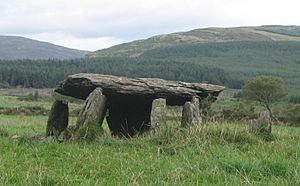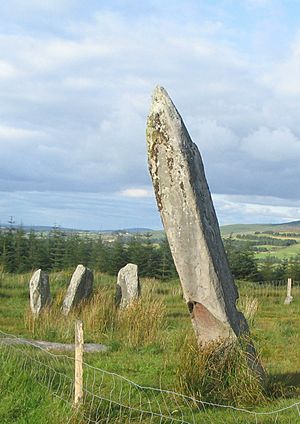Knocknakilla facts for kids
Knocknakilla is the site of a megalithic complex situated between Macroom and Millstreet, in County Cork, Ireland. It is set in blanket peatland on the north-west upper slopes of Musherabeg mountain and is thought to be 3500 years old.
Environment
The mid-Cork area is rich in archaeological artifacts, and the surrounding townlands contain two cashels, a ringfort, two fulacht fiadh, a possible souterrain and a circular enclosure. The word Knocknakilla is derived from the Irish Cnoc na Cille, as 'The Hill of the Church'.
Description

The site is located is on a level patch of bogland overlooking a deep valley and comprises a recumbent stone circle, a radial cairn and two pointy portal stones (one of which has fallen), aligned north-northeast to south-southwest. The stone circle is made up of five 1.3- to 1.5-metre-high stones, of which two (the axis and east sidestone) fell sometime in the last 50 years. Only the two northern portal stones and a stone at the west stand today. The stone row, made up of two stones both over 3.5 metres tall, seems to have been aligned on the stone circle, although the stone nearest the circle has fallen, and the remaining stone has a pronounced lean.
Three meters away is a 10-stone, 3.5-metre-diameter, radial cairn which was first discovered by Coillte Teoranta in 1970. The upright standing stone is 3.7 metres tall, and it leans heavily to the north.
Knocknakilla is best known for its large, now leaning, portal stone. Given the stones' relation to both the rising and setting sun, it is thought that they were aligned with purpose and functionality in mind, likely as calendars to early farmers, probably related to harvest or fertility ceremonies.


